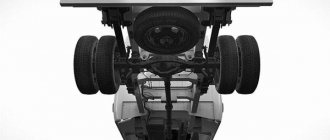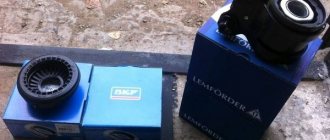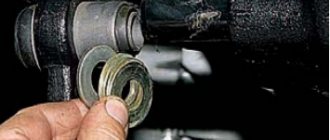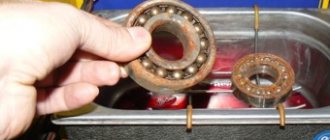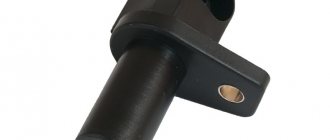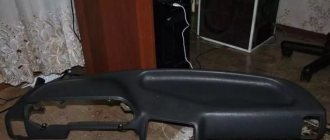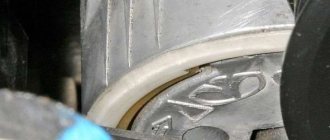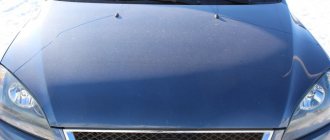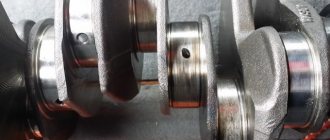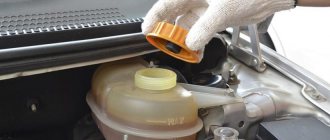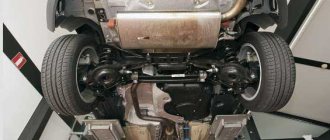Diagnostics of silent blocks in the front control arms.
Why do silent blocks need to be changed over time? There are several reasons for this:
- Over time, rubber loses its elastic properties and begins to crack.
- During use of the machine or during its maintenance, oil got onto the silent block.
- Incorrect installation of the part.
- Driving on very bad roads, of which there are a great many in Russia.
Everything is diagnosed quite simply. The first thing that should alert you is the deterioration in the responsiveness of the steering wheel. But this may not be the case only, let’s look further. The second sign of dead silents, the wheels are standing like a house. On the pit or on the lift, check the integrity of the rubber bands (they should not have cracks and they should not be squeezed out). You can take a crowbar or a pry bar and try to move the levers. They should not have free movement (should not dangle).
Replacing silent blocks in the upper control arm of a classic with your own hands.
So, let's begin! In rear-wheel drive VAZs, the silent blocks in the upper arm can be changed without even driving into a hole and without removing the arm from the ball (provided that you have a remover for silent blocks). But first you need to determine whether the bushings of the silent blocks are stuck to the bolt securing the lever to the body. To do this, jack up the car and remove the wheel.
Arrows point to bolt and nut
We loosen the nut securing the upper arm with a 22mm wrench and try to turn the bolt. If it spins and the bushings stay in place, then you're in luck! But if this bolt rotates with great force and the bushings rotate with them, then as they say: “Houston, we have problems!” Next we will consider both cases.
If the silent blocks are not stuck.
Further actions depend on whether you have a puller for silent blocks. If there is one, then you don’t have to remove the lever completely, but just unscrew the nut 22 to the end, take out the bolt and turn the lever towards yourself (for the convenience of further repairs).
We turn the lever for convenience.
Next, take a puller and press out the silent blocks.
Removing the silent block using a puller
And with his help we press in new silent blocks. Before pressing, the mounting hole must be cleaned and preferably lubricated with lithol. In the upper arms, silent blocks are pressed into place up to the ribs, as shown in the photo below.
The new silent should be pressed in exactly like this.
But what to do if you don’t have a silent block remover ? Then you will have to completely remove the lever. We take out not only the bolt securing the upper arm to the body, but also take out the ball from the hub (this is faster than unscrewing 3 bolts securing the ball to the arm). Detailed removal of the ball joint is written here.
We removed the lever, put the lever ear on a pipe or on a yew tree (as in the photo), the main thing is that the silent block does not rest against anything, and knock it out with a hammer.
To press in new ones, we need a mandrel (old bearing, piece of pipe, nut head). The inner diameter of the mandrel must be equal to the diameter of the skirt of the new silent block. And we begin pressing in new parts using this mandrel, having previously lubricated the seat with lithol. Reassemble in reverse order.
Important: we pull the bolt securing the lever to the body only under the load on this wheel! Those. The car should not be on a jack, but on all wheels!
If the silent blocks are stuck to the bolt.
This is a very difficult case, since you will have to spend a long time trying to get the bolt that secures the front upper arm to the body.
For those who want to save themselves a lot of time and are ready to fork out a little, I advise you to buy a new bolt, this lever from disassembly and just cut off the old bolt with a grinder.
Well, if you have time and nerves, then we take a gas burner in our hands and burn out the silent block. Follow fire safety precautions! After all the rubber has burned out, you can begin to knock out the bolt. Get ready to do this for a very long time. After you remove the bolt, knock out the remaining clip of the burnt silent tape from the lever and follow the instructions written above.
Replacing silent blocks in the lower arm of a VAZ 2107, classic.
Here, when replacing, we can no longer do without an inspection hole or a lift.
To begin, use a 24mm wrench to unscrew the nuts securing the lever. Next, if you have a puller, then use it to press out the silent blocks. If there is no special puller, then we simply take a mandrel with a diameter larger than the diameter of the silent block. We set the mandrel as shown in the photo and hit it with a hammer. At the same time, we rest the lever using a mounting tool or a crowbar, as in the photo. Thus, we remove the silent blocks in the lower arms.
Remove silent blocks without a puller
How to remove stuck silent blocks in the lower front control arm.
Stuck silent blocks cause a lot of trouble when removing them. In order to get rid of them you need a gas torch and a hammer with a core. We burn out the rubber and tap the iron bushings on all sides. After that we try to knock them out using a core and a hammer.
If the nuts securing the lever shaft are not stuck, then it is better to completely remove the lever (this will make it easier to knock the bushings out of the shaft). To do this, you will also need to remove the ball from the hub. Above in the article there is a link on how to remove the ball joints.
Pressing silent blocks into the lower arm.
New silent blocks are pressed into the lever until it stops. This can be done using a puller or a mandrel of a suitable diameter; you can use a head as a mandrel.
After installing the new levers, tighten the nuts and release the car onto the wheels. Only after this do we fully tighten the nuts.
Of course, it will be clearer to see how everything is done once than to read it a hundred times. Especially for you, I am attaching a video about replacing silent blocks in the front arms of a rear-wheel drive VAZ.
Replacing front suspension silent blocks on a VAZ classic
To replace silent blocks, we will need a special typesetting puller.
In a worn silent block, the rubber stretches, cracks and is squeezed out. If it still doesn’t creak when the suspension is operating, then it’s a matter of time. For convenience, many people remove the lever from the car and work with it separately. Personally, I prefer not to spend a lot of time removing and installing the lever, so I change the silent blocks on site. To begin with, you should unload the car's suspension by lowering the lever onto wooden blocks so that the wheel does not touch the ground. Let's start, perhaps, with the top ones. Remove the wheel and clean the upper arm mounting nuts. Then you need to unscrew the nut on the left side and use a hammer to knock out the axle to the right. To avoid damaging the axle, place a block of wood and tap it with a hammer or use a rubber mallet. In order for the axle to come out, unscrew two or three screws from the fender liner on the right side and bend it. When the axle is out, we pull the upper lever towards us until it stops, and we get a comfortable working space.
We take our puller and thread the bolt through the silent block. If the silent block is pressed out from the right side, then to the left of it a thick puller washer is installed, which is supported by a nut, and to the right is a mandrel with a window. By tightening the nut, the washer squeezes the silent block into the mandrel. We do the same with the left silent block, only we install the puller in reverse.
The seat does not need to be lubricated with anything so that the new silent block holds tighter and does not rotate in the lever. Personally, I lubricate the lever axle with Negrol so that during the next repair it does not turn sour and can easily come out. We press in the right silent block until its ribs rest against the lever, while a bolt is threaded through it, a mandrel is threaded on the left, and a mandrel with a window on the right to see how pressed the silent block is. We press in the left silent block in the same way, only the puller is installed in reverse.
Replacing silent blocks VAZ 2105
- Posted by: admin;
- Read: 14069;
- Date: 04/29/2014, 16:52;
After reading the above, I think you already understand that silent blocks play an important role in a car’s suspension and replacing them is a labor-intensive process. What conclusion can be drawn from this? Right. Don’t skimp, buy only branded silent blocks. I won’t engage in advertising (especially free advertising), I’ll just say that you can pay attention to silent blocks from SEVI and Trek. An even better option is to buy and install polyurethane silent blocks on your car.
Did you buy it? Then further...
Let's start with replacing the silent blocks of the upper control arms on the VAZ-2101, VAZ-2102, VAZ-2103, VAZ-2104, VAZ-2105, VAZ-2106, VAZ-2107.
Loosen the wheel bolts and use a jack to lift the required wheel. Then we remove it and use a 24mm wrench to loosen the nut on the axis of the upper arm (photo 3). You can immediately unscrew the steering tip nut and unpress it, see photos 5 and 6.
How to replace silent blocks on a VAZ 2107
Replacing the silent blocks of the front levers on VAZ 2101 - 2107 cars is not an easy task. However, they still need to be changed from time to time, and most car enthusiasts have learned to do this without much difficulty. A special universal puller will help to significantly simplify this work. It is with its help that both the upper and lower silent blocks are replaced.
So, you have come to the conclusion that it is time to replace the silent blocks. You should start by purchasing them. Today there are many domestic and imported products on the auto parts market. They differ from each other in price, quality, and service life. Experts recommend installing polyurethane ones as the most reliable and durable, however, due to the fairly high price, they are not affordable for everyone.
For the replacement process itself, it does not matter at all whether the silent blocks are polyurethane or rubber; they are changed on the VAZ 2107 in exactly the same way. From the tool you will need:
- Silent block remover;
- Ball joint remover;
- Keys for 13, 22, 24;
- Hammer;
- Chisel;
- Mount;
- Penetrating lubricant (eg WD-40).
You should start by hanging the front end on a jack and removing the front wheel. Next, we proceed directly to the replacement procedure. For the upper and lower front arms of the VAZ 2107, the order of work is different, so we will consider both options. To simplify the work, it is recommended to pre-treat all threaded connections of the levers with penetrating lubricant.
Silent blocks VAZ 2107
On the Internet, the specifics of replacing the silent blocks of the suspension of the VAZ 2107 and other cars of the domestic and foreign automobile industry are often discussed. The problem is actually urgent and is due to the poor quality of our roads. Since the silent block is one of the important elements of the vehicle suspension design, special attention must be paid to its selection and replacement.
It will be useful: How many liters of antifreeze in Kia Rio
What are silent blocks
The silent block (hinge) structurally consists of two metal bushings connected to each other by a rubber insert. The part is designed to connect suspension elements, and the presence of rubber allows you to dampen vibrations that are transmitted from one unit to another. The silent block must perceive and endure all deformations to which the car suspension is subjected.
Where are they installed?
On the VAZ "Seven" silent blocks are installed in the front and rear suspension. At the front, levers are attached using this part, and at the rear, reaction rods (longitudinal and transverse) connect the axle to the body. To ensure that the car's suspension is always in good condition and handling does not deteriorate, you need to monitor the condition of the silent blocks and replace them in a timely manner.
What types of silent blocks are there?
In addition to the purpose of silent blocks, you need to know that these products can be made of rubber or polyurethane. It is generally accepted that replacing rubber suspension components with polyurethane ones, where possible, will only improve the characteristics and performance of the suspension.
Silent blocks made of polyurethane are characterized by a longer service life, unlike rubber ones.
The disadvantage of polyurethane elements is their high cost - they are about 5 times more expensive than rubber ones. When installing polyurethane products on a VAZ 2107, you can improve the car's behavior on the road, reduce deformations in the suspension, and also eliminate the so-called squeezing, which is characteristic of rubber elements. This means that the suspension will operate in the condition intended by the designers at the factory. With the correct selection and installation of polyurethane parts, noise and vibration are reduced and shocks are absorbed, which indicates the better performance of such hinges compared to rubber ones.
Reasons for failure
When encountering failures of silent blocks for the first time, it is quite difficult to imagine what can happen to these products after long-term use. Over time, the rubber begins to tear, resulting in the need to replace the hinge. There may be several reasons why a product becomes unusable:
- High mileage of the car, the consequence of which was the drying out of the rubber, loss of its elasticity and the appearance of cracks and tears.
- Contact of chemicals with the rubber of the silent block. Since the suspension element in question is located near the engine, it is likely that it will be exposed to oil, which leads to the destruction of the rubber.
- Incorrect installation. Fastening the bolts of the levers should only be done after the car is installed on the wheels and not hung on a lift. If tightened incorrectly, the rubber of the silent block becomes strongly twisted, which leads to rapid failure of the product.
Checking status
It would be a good idea for the owners of the “Seven” to know how to determine that the silent blocks need to be replaced. High-quality products last for quite a long time - up to 100 thousand km. However, due to the condition of our roads, the need to replace them usually arises after 50 thousand km. You can determine that the rubber joints have become unusable by how you feel while driving the car. If the car begins to handle worse, the steering wheel is no longer as responsive as before, then this indicates obvious wear and tear on the silent blocks. To be more confident, it is recommended to visit a service station so that specialists can diagnose the suspension.
The condition of silent blocks can be determined independently by visual inspection. To do this, you will need to drive the car onto an overpass or inspection hole, and then inspect each of the hinges. The rubber part should not have cracks or tears. One of the signs of failure of silent blocks is a violation of wheel alignment. In addition, a sign of wear on the part in question is uneven wear on the tire tread. This phenomenon indicates an incorrectly adjusted wheel alignment, which may be causing the vehicle's suspension to malfunction.
There is no point in delaying the replacement of silent blocks, since over time the seats in the levers become broken, so the lever assembly may need to be replaced.
Video: diagnostics of silent blocks
Replacing the upper silent blocks
First of all, you should unscrew the vertical bolt securing the bumper, as it will interfere with removing the axle. Next, unscrew the nut securing the ball joint and, using a special puller, press the ball pin out of the bipod.
After that, using two 22mm wrenches, twist the nut and remove the bolt securing the upper arm to the body. Now we will need a puller. Having clamped the removed part in a vice, use a puller to press out the old parts, and press new ones, polyurethane or rubber, in their place.
After the replacement is made, assembly is carried out in the reverse order:
- The lever fastening bolt is inserted and the nut is screwed on. You shouldn’t tighten it completely, we’ll do it at the very end;
- The ball joint is installed in place, the nut is tightened until it stops;
- The wheel is screwed on, the car is lowered and removed from the jack;
- Having turned the steering wheel, tighten the upper arm securing nut until it stops.
Replacing silent blocks
The process of replacing silent blocks of the VAZ-2106 suspension can be divided into two stages:
- Replacement of front suspension joints (upper and lower arms).
- Replacing the silent blocks of the rear suspension torque rods.
Replacing the silent blocks of the upper arms
Replacing the silent blocks of one of the upper arms of the VAZ-2106 with your own hands is carried out in the following order (not forgetting about safety precautions):
- Loosen the bolts securing the desired wheel and jack up the car.
- Remove the wheel.
- Using two 13mm wrenches, unscrew the nuts securing the ball joint.
- Using two 22mm wrenches, remove the lever nut, remove the axle and dismantle the upper lever.
- Press out the hinge using a special puller
- The lever is fixed in a vice and, by tightening the puller bolt, the hinge is squeezed out of its seat.
- The second hinge is pressed out in the same way.
- Using the same puller, press in new parts and install the upper arm in place. To do this, repeat the steps in reverse order.
- Worn parts on the second lever are changed in the same way.
Replacing the silent blocks of the lower arms
Replace the rubber-metal joints on the lower arms in a similar way. Only in this case the latter are not removed from the car.
- Remove the desired wheel.
- Using a 22mm wrench, unscrew the axle nuts on both sides of the lever and remove the thrust washers.
- Screw the hollow bolt of the puller onto the axle. Then you need to tighten the nut, holding the bolt from turning. The puller glass will put pressure on the lower arm, gradually moving it away from the hinge.
- Insert the new hinge into place and center it in the hole, pressing the lever with a mounting blade. Then, installing the puller stop on the inside of the last one, press it in.
- Similar operations are carried out with the remaining silent blocks, after which all the removed parts are returned to their places.
Replacement of silent blocks of rear suspension torque rods
In order to replace worn silent blocks on VAZ-2106 thrust rods, you must:
- Place the car on a viewing hole or overpass.
- Remove all jet rods in the following order:
- long transverse rod;
- long pull to the right;
- left long pull;
- short left pull;
- right short pull.
- The rubber-metal joints of the torque rods are changed using procedures that are similar to those given above when describing the replacement of the silent blocks of the VAZ-2106 front suspension.
More information about the technology for replacing silent blocks of VAZ-2106 jet thrusts can be found at:
Replacing the lower silent blocks
Changing silent blocks on the lower arm of a VAZ 2107 is somewhat more difficult. All work is carried out directly on the car.
- Unscrew both nuts securing the lever;
- We screw the puller onto one side and squeeze out the silent block;
- We perform a similar operation on the opposite side;
- We install new polyurethane silent blocks one by one and press them into the lower arm using a puller;
- Install the thrust washers and screw on the self-locking nuts, not completely;
- We fasten the wheel and remove the car from the jack;
- Tighten the lower arm mounting nuts until they stop.
In this work, the puller plays an important role, since without it it is practically impossible to complete the work without removing the lower arm.
Since your safety directly depends on the serviceability of the VAZ 2107 chassis, periodic diagnostics and replacement of failed elements are necessary. To do this, it is advisable to purchase the most popular pullers, namely:
- Ball joints;
- Silent blocks;
- Tie rod ends.
Thanks to them, repairing the chassis of your VAZ 2107 will not cause any difficulties. And the use of high-quality components will ensure your safety for a long time. It is for these reasons that polyurethane silent blocks are recommended for installation.
Security measures
When performing repair work, do not forget about basic safety measures:
- Before hanging on a jack, the car is placed on the handbrake, and wheel chocks are placed under the wheels;
- In parallel with the jack, a safety support is installed under the body of the suspended car;
- When working with a hammer, for example, pressing a ball joint out of a bipod, use safety glasses;
- Wear gloves to protect your hands from damage if the wrench may slip off the nut.
Replacing silent blocks of the lower arm
When silent blocks fail, as a rule, they cannot be restored; this is due to their design. To carry out work on replacing the rubber-metal joints of the lower arm on a VAZ 2107, you will need the following tools:
- silent block remover;
- ball joint remover;
- keys for 13, 22, 24;
- hammer;
- chisel;
- mount;
- lubricant (for example, WD-40).
The procedure for dismantling the lower arm is as follows:
- Raise the car using a lift or jack.
- Remove the wheel.
- Loosen the lower arm axle nuts.
During assembly, new nuts should be used to tighten the lever shaft and ball pin.
Video: how to replace the silent blocks of the lower arms of a VAZ 2101–07
The same puller is used to remove and install silent blocks. You only need to change the position of the parts depending on what operation is intended (pressing in or pressing out).
Replacing the upper arms and their rubber-metal joints on a VAZ 2106 Zhiguli
- Repair manuals
- Repair manual for VAZ 2106 (Zhiguli) 1976-2005.
- Replacing the upper arms and their rubber-metal joints
Repairing auto parts yourself is a responsible task that should be taken as seriously as possible. Sometimes a faulty spare part takes the driver by surprise, forcing him to spend a lot of time and money searching for a good service station, but there is an alternative solution to the problem; this requires a small amount of knowledge and a set of tools.
When replacing the upper arms and their rubber-metal joints on a VAZ 2106 Zhiguli, you need to be extremely careful and not neglect the little things. To get acquainted with the issue, car enthusiasts often use various Internet portals dedicated to auto parts. Some of them use narrowly focused forums. But, as a rule, only generalized information is provided there, which is known initially. Where can you find a reliable source that offers really useful things? Our portal is open for this 24 hours a day. Online mode allows us to help clients at any time convenient for them. Moreover, a mobile version has been developed that is available to everyone.
A detailed description of such a unit as replacing the upper arms and their rubber-metal joints of the VAZ 2106 Zhiguli has a good structure with thematic headings. In addition, there is always the opportunity to familiarize yourself with the intricacies of installation. There are often situations when a driver is confident in his abilities, but when he gets down to work, questions begin to arise. Thanks to our portal, such moments can be easily avoided. The site is a database that is updated regularly. By using it as a support during repair work, the car enthusiast receives a serious advantage. Each of the articles has reliable support, tested in practice.
In addition to the repair manual, the owner of a personal car will be able to prevent a lot of breakdowns that occur due to the human factor, thanks to the information located on the site. Users are presented with a lot of useful recommendations for proper operation, which will help significantly extend the life of the unit and avoid many negative consequences.
Online support is an excellent and most convenient way to obtain the necessary information. Another significant plus is that articles are written for people. We understand that the reader will do everything with his own hands, and we try to make it as convenient and efficient as possible. Use the resource at any time of the day and find the answer to any question you may have regarding cars.
↓ Comments ↓
1. General information
1.0 General information 1.1 Safety precautions
2. Diagnosis of faults
2.0 Diagnostics of faults 2.1 diagnostics of faults in the engine and its systems 2.2 Diagnostics of faults in the clutch 2.3 diagnostics of faults in the gearbox 2.4 Diagnostics of faults in the driveline, rear axle, chassis, steering and braking system 2.5 Diagnosis of faults in the body 2.6. Diagnosis of electrical equipment faults
3. Engine
3.0 Engine 3.1 Cylinder head and timing mechanism 3.2 Lubrication system 3.3 Oil change 3.4 Replacing the camshaft drive chain guide 3.5 Replacing the camshaft and valve levers 3.6 Replacing the valve stem seals 3.7 Replacing the intake and exhaust manifold gaskets 3.8 Replacing the cylinder head gasket ov 3.9 Disassembling the head cylinder block, valve grinding
4. Engine power system
4.0 Engine power system 4.1 Replacing the air filter element 4.2 Replacing the fuel pump 4.3 Repairing the fuel pump 4.4 Replacing the fuel tank and its hatch cover
5. Carburetor
5.0 General information about the carburetor 5.1 Cleaning the fuel filter 5.2 Replacing the idle air system solenoid valve 5.3. Adjusting the carburetor 5.4 Replacing the carburetor 5.5. Carburetor repair
6. Engine cooling system
6.0 Engine cooling system 6.1 Replacing the coolant 6.2 Replacing the coolant pump 6.3. Replacing the thermostat 6.4 Replacing the engine radiator
7. Exhaust system
7.0 Exhaust system 7.1 Replacing exhaust system parts
8. Clutch
8.0 Clutch 8.1 Replacing fluid and bleeding the clutch hydraulic drive 8.2 Adjusting the drive 8.3 Replacing the clutch master cylinder 8.4 Repairing the clutch master cylinder 8.5 Replacing the clutch slave cylinder 8.6 Replacing the pressure plate assembly and clutch release bearing
9. Gearbox
9.0 Gearbox 9.1 Checking the level and changing the oil in the gearbox 9.2 Replacing the reverse light switch 9.3 Replacing the secondary shaft cuff 9.4 Replacing the gearbox 9.5 Repairing the gearbox 9.6 Replacing the speedometer drive 9.7 Features of repairing a five-speed gearbox
10. Cardan transmission
10.0 Cardan transmission 10.1. Maintenance 10.2. Replacing the driveshaft
11. Rear axle
11.0 Rear axle 11.1 Checking the serviceability of the rear axle 11.2 Changing the oil 11.3 Replacing the axle shaft and its cuff 11.4 Removing and installing the rear axle 11.5 Replacing the cuff of the drive gear 11.6 Replacing the gearbox 11.7 Repairing the gearbox
12. Front suspension
12.0 Front suspension 12.1. Maintenance 12.2 Replacing the bearings and hub cuff 12.3 Replacing the cushions and stabilizer bar 12.4 Replacing the ball joints 12.5 Replacing the shock absorbers 12.6 Replacing the springs 12.7 Replacing the upper arms and their rubber-metal hinges 12.8 Replacing the rubber-metal joints of the lower arms on a car 12.9 Replacing the lower arms 12.12 . Adjusting wheel alignment angles
13. Rear suspension
13.0 Rear suspension 13.1 Checking technical condition 13.2. Replacement of rear suspension parts
14. Steering
14.0 Steering 14.1 Adding oil 14.2 Checking the condition of the steering 14.3 Adjusting the gear engagement 14.4 Replacing steering rods 14.5 Replacing and repairing the pendulum arm 14.6 Removing and installing the steering wheel 14.7 Removing and installing the steering shaft 14.8 Removing and installing the steering mechanism 14.9 Removing the bipod
15. Brake system
15.0 Brake system 15.1 Checking the condition of the hydraulic drive 15.2 Checking the vacuum brake booster 15.3 Checking the functionality of the pressure regulator 15.4 Replacing brake fluid and bleeding the brake system 15.5 Replacing the brake pads of the front wheels 15.6 Replacing the brake pads of the rear wheels 15.7 Replacing the brake caliper of the front wheel 15.8 Replacing the brake cylinders of the front wheels 15 .9 Repair of front wheel brake cylinders
16. General information
16.0 General information 16.1. Checking electrical circuits 16.2 Fuse blocks 16.3 Replacing fuses 16.4 Replacing the main and additional fuse blocks 16.5. Replacing the relay 16.6 Replacing the ignition switch 16.7 Replacing the contact part of the ignition switch 16.8 Battery 16.9. Generator 16.10. Starter 16.11. Ignition system 16.12. Lighting, light and sound alarms 16.13. Windshield cleaner and washer 16.14. Repair of the electric heater motor 16.15. Control devices
17. Body
17.0 Body 17.1 Replacing the front bumper 17.2 Replacing the radiator grille 17.3 Replacing the hood latch 17.4 Replacing the hood 17.5 Replacing the windshield 17.6 Replacing the interior rear view mirror 17.7 Replacing the sun visor 17.8 Replacing the headliner 17.9 Replacing the ceiling grab handle
18. Heating and ventilation system
18.0 Heating and ventilation system 18.1 Replacing the electric heater fan 18.2 Replacing the heater radiator 18.3 Replacing the radiator casing 18.4 Replacing the heater valve
19. Car body care
19.0 Car body care 19.1 Car washing 19.2 Preservation and protection of paintwork
20. Applications
20.0 Applications 20.1 Tools used in addition to the standard set 20.2 Electrical diagram of VAZ-2106, VAZ-21061, VAZ-21063 cars produced in 1976–1987. 20.4 Tightening torques for threaded connections 20.5 Basic data for adjustments and monitoring 20.6 Characteristics of spark plugs 20.7 Fuel, lubricants and operating fluids used 20.8 Lamps used on the vehicle 20.9 Lip seals (oil seals)
| EXECUTION ORDER |
Replacing the upper arm joints
To replace the silent blocks of the upper arm, you will need the same tools as when repairing the lower elements. The car is lifted in the same way and the wheel is removed. Then carry out the following actions:
- Unscrew the front bumper bracket fasteners.
Replacement of silent blocks of reaction rods
Tie rods are an integral part of the rear suspension of classic Zhiguli cars. They are secured by a bolted connection, and rubber bushings are used to reduce loads and compensate for impacts from uneven road surfaces. Over time, these products also become unusable and require replacement. It is best to change them comprehensively, rather than individually.
Tools and materials you will need:
- keys to 19;
- new silent blocks;
- penetrating lubricant;
- metal brush;
- mounting blade.
Let's consider replacing torque rod bushings using the example of a long longitudinal rod. The procedure with other suspension elements is carried out in a similar way. The only difference is that to remove the long rod, you need to remove the lower shock absorber mount. The work consists of the following steps:
- Clean the fastener from dirt with a brush, treat it with a penetrating liquid and wait for a while.
If the inner race protrudes slightly on one side, it needs to be leveled with a hammer.
After replacing the silent block, the rod is installed in the reverse order, not forgetting to lubricate the bolts, for example, with Litol-24, which will make it easier to dismantle the fasteners in the future.
Video: replacing torque rod bushings on a VAZ 2101–07
Do-it-yourself silent block remover
The VAZ 2107 hinge puller can be purchased ready-made or made by yourself. If you have the right equipment and materials, every car enthusiast can make the tool. It is also worth considering that the quality of purchased devices today leaves much to be desired. You can replace the rubber-metal hinge without special tools, but this will require much more time and effort.
Sequencing
To make a homemade puller you will need the following:
- a piece of water pipe 3 cm long with an internal diameter of 40 mm and an external diameter of 50 mm;
- washer with an outer diameter of at least 50 mm;
- M12 bolt 7 cm long with washers;
- two pieces of pipe 10 cm long and 40 mm in diameter;
- vice;
- hammer;
- lubricant
The puller manufacturing process consists of several stages.
- By striking with a hammer, they ensure that a 40 mm pipe section has an internal diameter of 45 mm, i.e., they try to rivet it. This will allow the lower arm joint to pass freely through the pipe.
In order to drive your car confidently and without accidents, you need to periodically inspect and repair the chassis. Wear of silent blocks affects driving safety, as well as tire wear. To replace damaged hinges, you will need to prepare the necessary tools and perform repairs in accordance with step-by-step instructions.
Replacement of silent blocks of VAZ-2107. DIY puller and mandrel
ATTENTION! There was a mistake in the video - under no circumstances should the seats except the lever axis be lubricated!
Last time we completely dismantled the front suspension, replaced the ball joints, and it was time to replace the silent blocks.
Since they cannot be replaced without special tools, and buying pullers is not cheap, so we will make them from scrap materials.
- A piece of water pipe with an internal diameter of 45 mm, an external diameter of 50 mm (can be made from a 40 mm pipe) 2.5-3 cm long
- Large washer or plate with a diameter of at least 50 mm
- Bolt M12-14 6-7 cm long with washers
- Two pieces of pipe with a diameter of 40 mm, 5-10 cm long
- Hammer, vice
- WD-shka or other liquid wrench, lubricant
Using a hammer, we beat off a piece of the 40th pipe on an anvil, bringing its internal diameter to 45 mm, so that the silent block of the lower arm passes through it freely; or find a tube of suitable diameter. We will use this mandrel to remove silent blocks.
From the same 40th pipe we cut two more pieces - we will use them to press in new silent blocks.
First, we clean all the places where the silent blocks are attached and treat them with WD.
Let's start with the upper arm. To do this, take a bolt, put a thick-walled washer (or washers) on it, no smaller than the diameter of the inner and no larger than the outer bushing of the silent block (preferably).
We insert the bolt into the block from the inside of the lever, put on the large mandrel we made on the outside so that it rests against the walls of the lever, insert a large washer and tighten the nut.
As you tighten it, the mandrel will rest against the lever, and the bolt with washers will begin to pull the silent block into it. The main thing is to rip the block out of place, and then it’s a matter of technique - you’ll need a large screwdriver and a hammer.
Now, let's move on to pressing in new silent blocks; for this we prepared small mandrels of 40, their diameter exactly coincides with the diameter of the “ear” of the outer bushing of the silent block.
We first clean the seats, insert the silent block in the center of the imaginary axis and adjust the mandrel. On the other side, we place a large mandrel and rest it against a yew or an anvil to prevent possible deformation of the lever. Using sharp blows of a hammer on the mandrel, press the hinge into place.
The upper silent blocks are pressed in until their “bobs” rest against the lever, unlike the lower ones, which must be driven in close to the wall of the lever.
Now let's move on to the lower lever - there they change in a similar way.
First, remove the nuts and thrust washers on both sides of the lever axle, install a large adapter, a large washer and tighten the axle nut - it is advisable to use an unnecessary nut for this.
The role of the pressure bolt here is played by the lever axis itself.
If the silent block is soured, then using gentle blows on the side of the lever or the mandrel itself, we try to tear it off, tightening the nut.
When installing new silent blocks, we clean the seats of the levers, you can lightly lubricate the axle.
We start the axle and attach silent blocks, place small mandrels on the silent blocks on both sides and, using a hammer, press in first one, then the other.
The lower silent blocks are pressed flush.
Next time we’ll look at how to replace the front springs and whether there will be a difference in ground clearance after replacement.
Replacement of front levers of Lada 2105 (VAZ 2105)
Symptoms: knocking noises in the front suspension.
Possible cause: the silent blocks of the upper arm of the front suspension are damaged.
Tools: set of wrenches, set of screwdrivers, rubber joint puller, jack.
Note. The silent blocks of the upper front suspension arms can be replaced without removing the arms themselves, which is what this instruction actually describes.
1. Suspend the front of the car using supports or jacks.
2. Remove the front wheel from the side from which you intend to replace the joints.
3. Using a 22mm wrench, unscrew the self-locking nuts of the lever axle on both sides, and then remove the washers.
4. Screw the hollow bolt of the removable device onto the axis of the lower arm of the front suspension and, securing the bolt from turning, tighten the nut. In this case, the glass of the removable device must press the lever and press the silent block off it.
5. Remove the silent block from the suspension arm.
6. Compact the silent block on the other side of the lever in the same way.
7. Center the new silent block in the hole of the suspension arm.
8. To prevent the lever from moving relative to the axle when pressing the hinge, place a thrust washer on the axle from the opposite side, and then tighten the old self-locking nut.
9. Install the remover onto the axle, and then tighten the nut. During this operation, the puller glass should press on the flange of the rubber-metal hinge, pressing it into the lever. Remember that when pressing the hinge onto the removable device, it is necessary to install a glass with a smaller diameter.
10. Unscrew the screw and remove the puller. Install the thrust washer onto the lever shaft and tighten the new self-locking nut (do not tighten it with maximum torque).
11. Press the hinge on the other side of the lever in the same way. Install the washer and then tighten the new nut.
12. Place the car on the wheels and finally tighten the nuts securing the arm to the axle.
More articles on repairing this car:
Other types of repairs for this vehicle:
Removing the upper front suspension arm on a VAZ 2105 car is performed either to replace worn silent blocks, arm fastening elements, or to completely replace it in case of serious mechanical damage. To carry out repair work, prepare a standard set of tools, and then perform the following sequence of actions:
- We set the car to the parking brake and, for prevention, place wooden blocks under the rear wheels. Then we jack up the side to be repaired and remove the wheel, having first loosened the wheel bolts.
- Next, to make dismantling work easier, unscrew the bolt securing the front bumper bracket and remove it.
- Unscrew the bolts securing the upper ball joint to the lever.
- Now we need to unscrew the self-locking nut securing the lever axis. To do this, we use a twenty-two socket wrench. Then remove the nut and the washer located under it.
- Carefully remove the axle, grabbing it with pliers if necessary, and remove the upper suspension arm from the car.
- Now, depending on the purpose of the repair, we either completely change it or replace the silent blocks.
- We install the lever in a vice, after which we press the silent block from the eye of the lever with a special puller, which can be purchased at a specialized auto store.
- Similarly, using the same device, we press in new ones. To make them easier to fit, lubricate the eyes with grease.
At this point, the repair work to remove the upper arm of the front suspension and replace the silent blocks on the VAZ 2105 has been completed. Next we proceed to the installation. For ease of installation of the lever mounting axis, it is recommended to load the suspension; to do this, place a support under the lower lever and lower the jack. Then we insert the ball joint pin into the steering knuckle and fix its nut. Then we attach the ball joint housing to the upper arm. Make final tightening of all nuts after the vehicle is placed on the ground. Also, do not forget to lubricate all threaded connections. Be sure to replace all self-locking nuts - the ball pin, the lever axis fastening and the ball housing fastening bolts.
Almost every owner of a domestic car, especially a classic rear-wheel drive model, sooner or later faces problems large and small. Some units and parts fail and have to be replaced. Some repair work is performed at numerous car service stations, while some can be done yourself in your garage.
Such work includes replacing the silent blocks of the front and rear levers that have become unusable.
Diagnostics of the shock absorber condition
As for shock absorbers, there is nothing easier than checking them. Firstly, all their malfunctions can be felt while driving. If they do not work, then the absorption of road irregularities will be catastrophically weak. The shock absorber's job is to smooth out all the shocks that go to the car's suspension. When a wheel falls into a hole, the lower arm of the front suspension of the VAZ-2106 moves down, it is held in place by the pressure in the shock absorber.
Consequently, if the shock absorber is faulty, the suspension will move freely. Nothing will stop her from moving. Secondly, the presence of oil leaks on the shock absorber body should alert you. Even if just a little is squeezed out, where is the guarantee that the remains will not escape? In addition, the seal is clearly damaged. Press down on the car body, forcing it to the ground, and then quickly release it. Ideally, the body should make only one upward movement, no more!
What is a silent block
Rubber and polyurethane silent blocks that have become unusable should be replaced as quickly as possible. Failure of parts of levers and other suspension components significantly worsens vehicle handling and increases wear on the rubber of the front wheels as a result of camber and toe problems.
- devices to facilitate the pressing process;
- remover for VAZ 2107 silent blocks and steering tips;
- jack;
- a set of open-end and ring wrenches for “22” and “13”;
- well sharpened chisel;
- plumber's hammer;
- mount.
What are silent blocks
A silent block is a special hinge made of steel bushings separated by a rubber insert. This element connects the nodes that make up the front suspension, as well as the rear. The soft layer helps dampen the vibration that accompanies vehicle movement.
The part in question can significantly extend the service life of more expensive suspension elements. At the same time, it itself breaks down quite quickly, so it has to be changed periodically.
In the case of the VAZ-2107, silent blocks on:
- the front suspension is used to softly fix its arms;
- rear - connect reaction rods that attach the chassis directly to the body.
Here it is worth mentioning one important nuance - depending on the location, silent blocks differ in size, so when purchasing an incomplete set you need to be as careful as possible. The parts under consideration are made not only on a rubber basis - there are options where polyurethane is used. The latter are considered the most reliable, but they also cost much more.
It will be useful: Replacing the VAZ 2110 gearbox with your own hands
Regardless of what type of silent blocks you purchased, you must constantly monitor their condition and change it as soon as its service life expires. This will eliminate a more serious problem - failure of the entire suspension.
Replacement
- you need to loosen the nuts on any of the front wheels;
- After this, the car should be raised and the wheel removed from the studs;
- for safety, additional support is needed (bricks, wheels with rims, a log), which is installed under the car in the area of the threshold;
- next you need to loosen the nut located on the upper arm, unscrew the nut on the steering tip, then unpress it;
- unscrew the nut of the upper ball joint;
- using a puller, unpress the pin from the bipod of the support;
- remove the axle from the upper arm by unscrewing the nut;
- the upper lever must be clamped in a vice on a workbench and the old silent blocks must be pressed out;
- install new parts and reassemble the entire assembly in reverse order, treating the axle on the front arm with nigrol, engine oil or other lubricant.
Work is carried out similarly to replace silent blocks on the other side of the machine. New front suspension parts have been installed.
- the wheel is removed;
- unscrew the nuts and remove the washers from the rear lever axis;
- the silent block is dismantled with a puller, the glass of which rests on the lower arm;
- the new silent block is centered in the lower arm in a special hole;
- After pressing, the puller is removed, thrust washers are installed and the nuts are tightened.
Replacing silent blocks can be carried out without removing the upper and lower control arms from the car. In this case, only the lever axis is removed. If you have certain skills, everything is done quite quickly.
Replacing springs and shock absorbers
Even if you only have one shock absorber leaking or a spring is cracked, you need to change everything on the front side. There is no need to test the body and the car as a whole, and at the same time yourself. Uneven wear of these elements is a guarantee that the car will become uncontrollable when cornering. To replace the front shock absorber, your best bet is to use a pit. But you can call on your ingenuity to help and do everything on a flat surface, but first you need to dig a small depression. When replacing the front suspension arms of a VAZ-2106, such manipulations with removing the shock absorber are not necessary.
It should be located clearly under the lower arm. Now you need to do a few simple steps - unscrew the rod nut (this fastening is located in the engine compartment). After this, unscrew the two nuts that are located on the lower arm. That's all, you can pull the shock absorber down by pressing the rod all the way. Installation of a new shock absorber must be carried out in the reverse order. As for the springs, they must be replaced if they are damaged or cracked. Comfort and control of the car also deteriorate as a result of the springs sagging. Under the influence of the weight of the car, they decrease in length, which affects the condition of the suspension.
